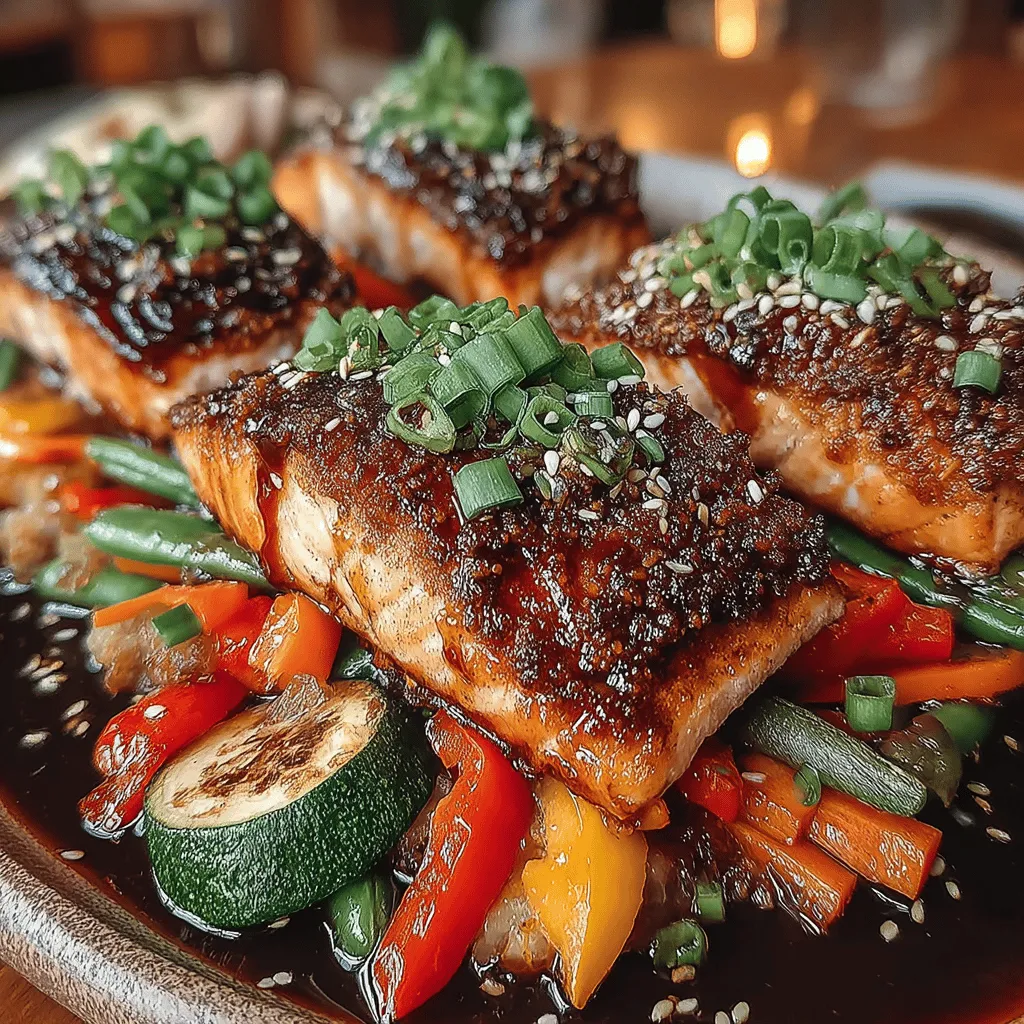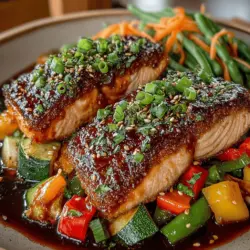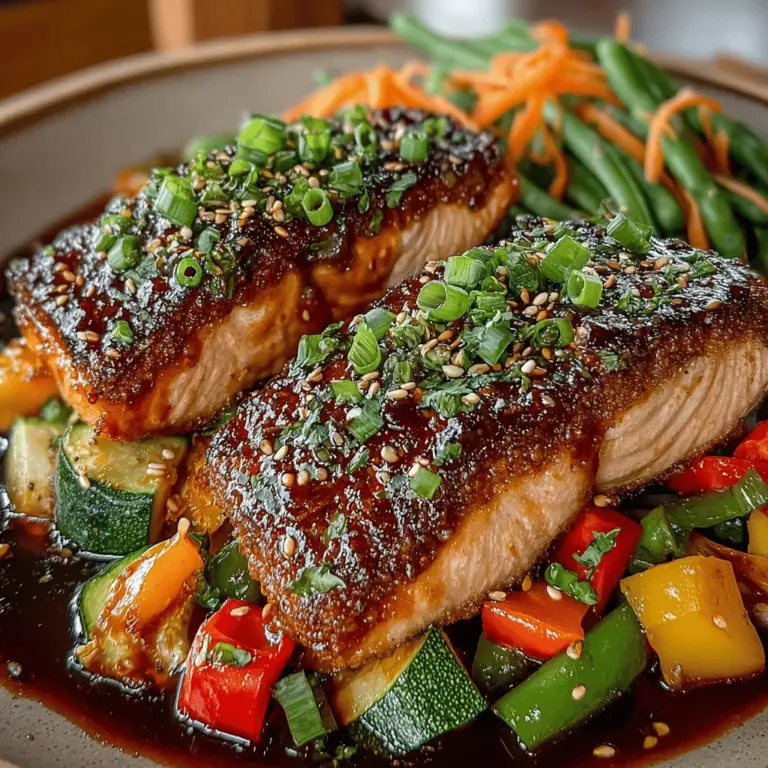Teriyaki Glazed Salmon with Colorful Veggie Medley: A Flavorful and Healthy Dinner Option
When it comes to dinner options that are both nutritious and visually appealing, few dishes can compete with Teriyaki Glazed Salmon paired with a colorful veggie medley. This dish not only tantalizes the taste buds with its sweet and savory flavors but also delights the eyes with a vibrant array of vegetables. Packed with essential nutrients, this meal is a perfect choice for health-conscious individuals and families looking to enjoy a balanced diet without sacrificing flavor.
The roots of teriyaki cuisine can be traced back to Japan, where it has evolved into a beloved culinary style recognized worldwide. The term “teriyaki” refers to a cooking method that involves grilling or broiling food and glazing it with a sweet soy sauce-based marinade. Its popularity has surged in modern cooking due to its versatility and the rich, umami flavors it imparts to a variety of dishes, particularly seafood and meats. The combination of teriyaki sauce with salmon creates a delightful harmony of flavors that is both satisfying and healthy.
Salmon is renowned for its health benefits, being rich in Omega-3 fatty acids and high-quality protein. These nutrients are essential for heart health, cognitive function, and overall well-being. When paired with an array of fresh vegetables, such as bell peppers, snap peas, zucchini, and carrots, this dish not only becomes a feast for the senses but also a powerhouse of nutrition. The vibrant colors of the veggies contribute not only to the visual appeal but also to a diverse range of vitamins and minerals that support a healthy lifestyle.
Understanding Teriyaki and Its Ingredients
At the heart of the Teriyaki Glazed Salmon is the teriyaki sauce, which has a distinct flavor profile characterized by its sweet, salty, and slightly tangy notes. Traditionally, teriyaki sauce is made from a combination of soy sauce, mirin (a sweet rice wine), and sugar. Over the years, variations have emerged, leading to the use of other ingredients such as sake or honey, depending on personal preferences and regional adaptations. The sauce not only enhances the taste of the salmon but also creates a beautiful glaze that caramelizes during cooking, adding depth to the dish.
Salmon itself offers a plethora of health benefits. It is not only an excellent source of Omega-3 fatty acids, which are known for their anti-inflammatory properties, but also provides a significant amount of protein, essential for muscle repair and growth. Additionally, salmon is rich in B vitamins, potassium, and selenium, all of which play vital roles in maintaining overall health.
The colorful vegetables used in this recipe—bell peppers, snap peas, zucchini, and carrots—are not only visually appealing but are also packed with nutrients. Bell peppers are an excellent source of vitamins A and C, while snap peas provide fiber and vitamins K and C. Zucchini is low in calories and high in antioxidants, making it a perfect addition to any meal. Carrots, rich in beta-carotene, contribute to eye health and offer a satisfying crunch. Together, these vegetables create a medley that complements the savory salmon while providing a balanced array of nutrients.
Ingredient Breakdown
1. Salmon Fillets: When selecting salmon, freshness is key. Opt for wild-caught varieties when possible, as they tend to have a superior flavor and nutrient profile compared to farmed salmon. If fresh salmon is not available, high-quality frozen options can be a convenient alternative. Always look for fillets that have a vibrant color and a clean smell, and avoid any fish that appears dull or has an off-putting odor.
2. Teriyaki Sauce: You can choose to make your own teriyaki sauce at home for a fresh taste and control over the ingredients, or you can opt for store-bought varieties for convenience. When selecting a store-bought sauce, look for options with minimal additives and a good balance of sweetness and saltiness. Homemade versions typically combine soy sauce, mirin, and sugar, which you can adjust to suit your taste preferences.
3. Olive Oil: A staple in many kitchens, olive oil adds richness to the dish while providing healthy fats. Extra virgin olive oil is particularly beneficial due to its high antioxidant content and anti-inflammatory properties. It is ideal for sautéing vegetables and can also be used in the marinade for the salmon to enhance flavor and moisture.
4. Vegetables: The colorful medley of bell peppers, snap peas, zucchini, and carrots not only adds visual appeal but also elevates the nutritional value of the dish. Bell peppers are rich in vitamins A and C, while snap peas provide fiber and essential nutrients. Zucchini is low in calories and high in water content, making it a great choice for hydration. Carrots contribute a satisfying crunch and are packed with beta-carotene, an antioxidant that supports eye health.
5. Aromatics: Garlic and ginger play crucial roles in enhancing the overall flavor of the dish. Garlic adds a pungent aroma and depth of flavor, while ginger contributes a warm, spicy kick that complements the sweetness of the teriyaki sauce. Both ingredients are known for their health benefits, including anti-inflammatory and immune-boosting properties.
Preparation Steps for Teriyaki Glazed Salmon
To create the perfect Teriyaki Glazed Salmon, the first step involves marinating the salmon fillets. This process is crucial for allowing the flavors of the teriyaki sauce to penetrate the fish, resulting in a more flavorful and succulent dish. Ideally, marinate the salmon for at least 30 minutes, but if time allows, extending this to a couple of hours will yield even better results.
When preparing the marinade, aim for a balance between the sweet and savory elements. If you’re making your own teriyaki sauce, ensure it’s not too thick; a consistency similar to that of a light syrup works best. If using a store-bought sauce, you may want to add a splash of water or a bit of olive oil to achieve the desired consistency.
As you prepare to cook the salmon, visual cues will help you determine when it’s ready. Look for salmon that has an opaque appearance and flakes easily with a fork—these are signs that it has reached the perfect level of doneness. Depending on the cooking method you choose (grilling, baking, or pan-searing), the cooking time may vary, so keep a close eye on the fish to avoid overcooking.
With the salmon marinating and the vegetables prepped, you’re well on your way to creating this vibrant and nutritious dish. In the next part of this article, we’ll delve deeper into the cooking methods for the salmon and veggie medley, ensuring you achieve a restaurant-quality meal right in your own kitchen.

Sautéing the Colorful Veggie Medley
Creating a vibrant veggie medley is not just about taste; it’s also about presentation and texture. When preparing vegetables, the way you cut them can enhance both their appearance and cooking time. Here are some techniques to elevate your dish:
Techniques for Preparing and Cutting Vegetables
1. Choose a Variety of Colors: Select a mix of vegetables such as bell peppers, broccoli, carrots, and snap peas. The more colors you incorporate, the more visually appealing your dish will be.
2. Cutting Styles: Aim for uniformity in size to ensure even cooking. For instance, julienne carrots and slice bell peppers into thin strips. Cut broccoli into bite-sized florets. This not only looks great but also helps in cooking them uniformly.
3. Prep Ahead: Wash and cut your vegetables before you start cooking the salmon. This way, you can focus on cooking without delays.
Importance of Cooking Temperature and Timing
When sautéing vegetables, achieving the right cooking temperature is crucial. Heat your skillet over medium-high heat and add a splash of oil. The oil should shimmer but not smoke.
– Timing: Add denser vegetables like carrots and broccoli first, allowing them to cook for a couple of minutes before adding softer vegetables like bell peppers and snap peas. This technique helps maintain the crunchiness of the vegetables, ensuring they don’t turn mushy.
How to Properly Season Vegetables
Seasoning vegetables is essential for amplifying their natural flavors. Here’s how to do it effectively:
– Use Salt and Pepper: A pinch of salt and a few cracks of black pepper will enhance the vegetables’ taste.
– Flavor Boosters: Consider adding minced garlic or ginger for an aromatic touch. A splash of soy sauce or teriyaki sauce can also bring the flavor profile together, creating a cohesive taste with the salmon.
Cooking the Salmon to Perfection
Cooking salmon perfectly can elevate your dish from good to extraordinary. Here’s how to achieve that perfect sear and doneness.
Step-by-Step Guide on Cooking Salmon in a Skillet
1. Prepare the Salmon: Pat the salmon fillets dry with paper towels. This step is essential for achieving crispy skin. Season both sides with salt and pepper.
2. Heat the Skillet: Use a non-stick or cast-iron skillet. Add a tablespoon of oil and heat over medium-high heat until the oil is shimmering.
3. Place the Salmon Skin-Side Down: Gently lay the salmon in the skillet, skin-side down. This method helps protect the flesh and allows for a crispy skin.
4. Don’t Move It: Allow the salmon to cook undisturbed for about 4-5 minutes. You’ll know it’s ready when the edges begin to turn opaque and the skin releases from the pan easily.
5. Flip and Finish Cooking: Carefully flip the salmon using a spatula and reduce the heat to medium. Cook for an additional 3-4 minutes, or until it reaches your desired doneness. The internal temperature should be around 125°F (51°C) for medium.
Significance of Cooking Time and Temperature
Cooking salmon at the right temperature is key to achieving the right texture. Overcooked salmon can become dry and unpalatable. If you prefer your salmon medium-rare, aim for a slightly shorter cooking time.
Alternative Cooking Methods for Versatility
While pan-searing is a fantastic way to cook salmon, there are other methods you can explore:
– Grilling: Preheat your grill to medium-high heat. Oil the grill grates to prevent sticking and cook salmon for about 4-5 minutes per side, depending on thickness.
– Baking: Preheat the oven to 375°F (190°C). Place seasoned salmon on a lined baking sheet and bake for approximately 12-15 minutes, or until the fish flakes easily with a fork.
Plating and Serving Suggestions
Plating your teriyaki glazed salmon with a colorful veggie medley can transform a simple meal into an elegant dining experience.
Creative Ideas for Plating
1. Layering: Start with a bed of sautéed vegetables on the plate, then place the salmon on top, allowing the vibrant colors to shine through.
2. Garnishes: Add a sprinkle of sesame seeds and chopped green onions for a fresh pop of color and flavor.
3. Drizzle: A light drizzle of extra teriyaki sauce over the salmon can enhance the visual appeal and add extra flavor.
Recommended Side Dishes
Pair your teriyaki salmon with nutritious side dishes that complement its flavors:
– Rice: Steamed jasmine or brown rice works well. The rice can absorb the delicious teriyaki sauce, enhancing each bite.
– Quinoa: For a gluten-free alternative, quinoa is a great choice. It adds a nutty flavor and boosts the protein content of your meal.
Suggestions for Additional Garnishes and Flavor Enhancements
– Fresh Herbs: A sprig of cilantro or parsley can brighten the dish.
– Lemon Wedges: A squeeze of lemon juice adds acidity that balances the sweetness of the teriyaki glaze.
– Avocado Slices: For added creaminess, consider garnishing with fresh avocado slices.
Nutritional Analysis of Teriyaki Glazed Salmon with Veggies
Understanding the nutritional profile of your meal is essential for making informed dietary choices.
Overview of the Nutritional Profile
– Salmon: A rich source of omega-3 fatty acids, high-quality protein, and essential vitamins such as B12 and D. It promotes heart health and supports brain function.
– Vegetables: The colorful veggie medley provides a range of vitamins, minerals, and antioxidants. Each vegetable contributes different health benefits, making this dish not only tasty but nutritious.
How This Recipe Fits Into a Balanced Diet
Incorporating salmon and vegetables into your diet can help achieve a balanced intake of macronutrients and micronutrients. This dish offers a satisfying combination of protein and fiber, promoting fullness and energy.
Benefits of Incorporating More Fish and Vegetables
1. Heart Health: Regular consumption of fish, particularly oily varieties like salmon, is linked to a reduced risk of heart disease.
2. Weight Management: High-protein meals can help curb appetite and maintain muscle mass during weight loss.
3. Nutrient Density: Vegetables provide essential vitamins and minerals with fewer calories, making them an excellent choice for any meal.
Conclusion
Teriyaki glazed salmon with a colorful veggie medley is more than just a meal; it’s a celebration of flavor, health, and simplicity in cooking. The key benefits of this dish include its delightful taste, nutritional abundance, and ease of preparation, making it perfect for busy weeknights or special occasions.
I encourage you to experiment with variations of this recipe, such as swapping in different vegetables or proteins like chicken or tofu. Enjoying colorful, nutritious meals not only satisfies the palate but also nourishes the body, promoting overall well-being. Whether you’re a seasoned chef or a kitchen novice, this teriyaki salmon recipe is sure to impress and inspire a love for healthy cooking.

